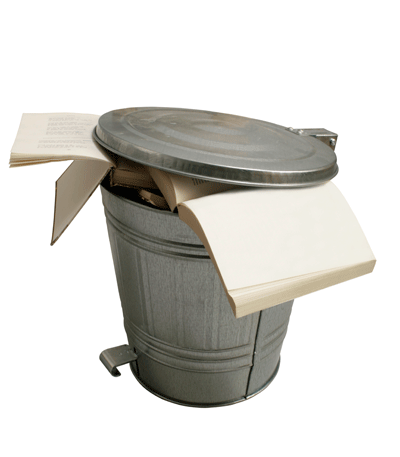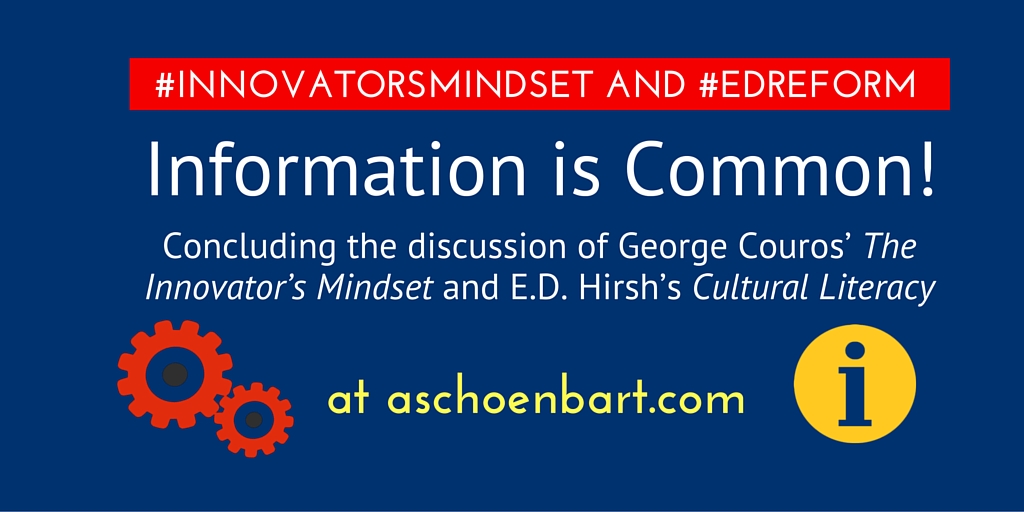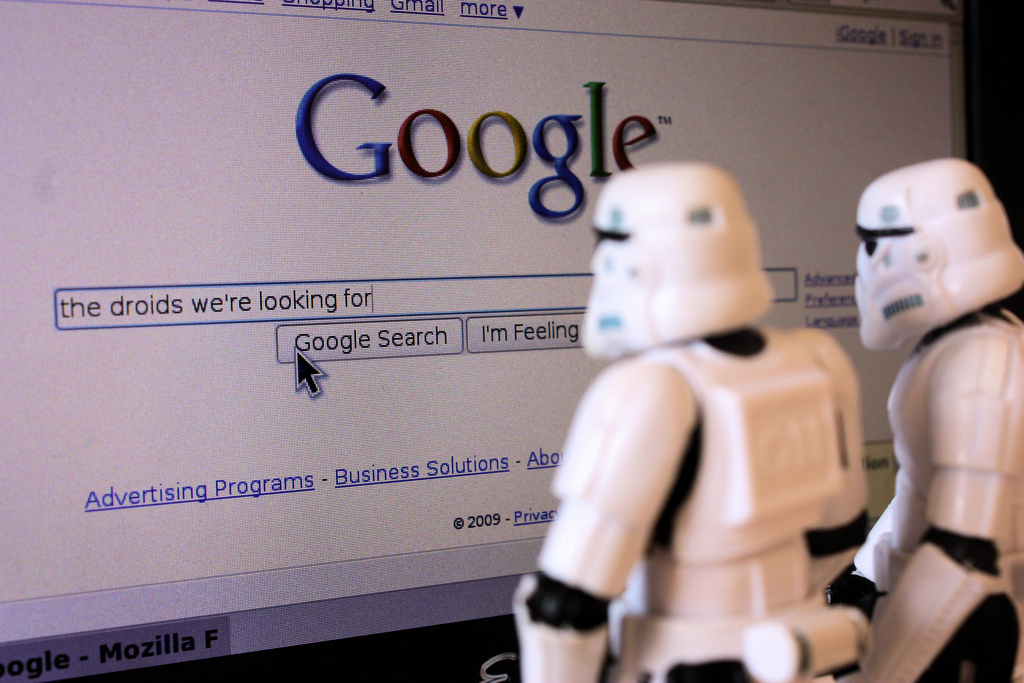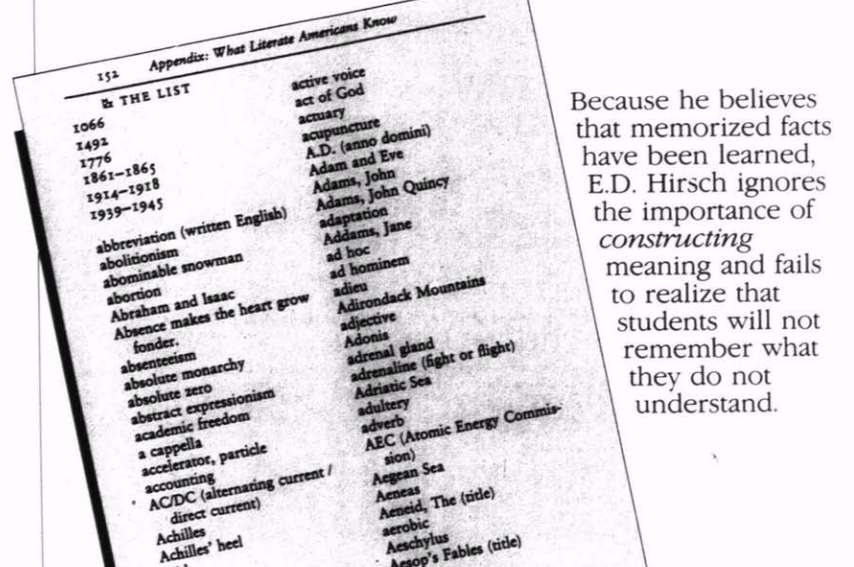Information Is Common! Returning To The #Innovatorsmindset


“Information is abundant; it’s common. What’s uncommon, and desperately needed in today’s education system, is the innovator’s mindset” (p. 41). This was one of those statements in Couros’ The Innovator’s Mindset that has stuck with me since I put the book down. I’ve often discussed the shift away from content to skills, or content through skills, with my students and teachers, and Couros captures the sentiment so clearly and effectively. When we can find anything online so easily and information is abundant, we need to stop asking Google-able questions and push students towards critical thinking.
This post continues and concludes (for now at least) a look into the #InnovatorsMindset through the lens of educational reform and in contrast to E.D. Hirsh’s Cultural Literacy. To recap from last time, I read both texts for a doctoral paper exploring change and controversy and wrote about them in What vs. How: #InnovatorsMindset and Ed Reform. I explored each author’s take on the skills and content that they thought would make our students ready for their futures.
Image courtesy of DocChewbacca on Flickr.

Today, I’ll share my analysis from my paper, focusing on what we teach, how we teach it, and the content vs. skills debate. With more reflection, I constantly come back to the understanding that content matters and does provide a context and schema for real understanding, but it matters less and less unless we can do more and more with it. It’s not what we know, but we are able to use it.
UPDATE: Check out George's post, Is a “Growth Mindset” Enough?, which responds to this very post. Thanks, George!
Unlocking Potential
Couros argues that “We are spending so much time telling our students about what they can’t do that we have lost focus on what we can do” (p. 7), to which Hirsh would counter: “Our children can learn this information only by being taught it” (p. 14). What and how seem to be at odds in this dynamic. Hirsh’s views on the limited potential of students are definitely problematic, writing, “Left to itself, a child will not grow into a thriving creature” (p. 31). Really!?!
While Hirsh wants students to simply memorize 150-pages-or-so of definitive knowledge and ideas, Corous seeks to expand worldviews: “Innovation demands that our students learn the basics, but how we go about teaching them may look different than in years past. The basics are crucial, but they cannot be the only things we teach our students” (p. 163). What we teach our students is crucial to both authors as information is key in both texts.
Tools and ideas to transform education. Sign up below.
Information in the Digital Age
We live in a digital and information age where virtually anyone can access anything at anytime. The access to information in 1987, when Hirsh first published, was different. Encyclopedias and dictionaries were impractical tools, Hirsh claims, so information had to be memorized. Otherwise, it was impossible to make meaningful connection and learn; “It is not enough to say that students can look these facts up” (p. 60).
For Couros, “Information is abundant; it’s common. What’s uncommon, and desperately needed in today’s education system, is the innovator’s mindset” (p. 41). With the innovator’s mindset comes skills but “skill . . . requires the rapid deployment of schemata that have already been acquired and do not have to be worked out on the spot” (Hirsh, 1988, p. 63).
Again for Hirsh, it’s about information first and foremost. With limited flexibility, he wants to tell America what to learn, to which Couros would likely respond: “You’ll learn that to truly empower people, there must be a shift from telling to listening” (p. 7). One can’t help but wonder how Hirsh’s views may have evolved in the new reality of technology and access to information.
An excerpt from the article “Cultural Literacy: What Every Educator Needs to Know” (1988) in Educational Leadership, showing a page for Hirsh’s list with commentary from the authors of the article, Estes, Gutman, and Harrison.

Both Couros and Hirsh constantly bring their arguments back to student learning. For Hirsh, it’s about repairing the damage to American education and thereby democratic society. For Couros, it’s about helping students reach their potential and prepare for the future. While Couros embraces change and advocates in positive and collaborative ways, Hirsh seems to fear it and how it might change society. He tries to explain how to allow for some flexibility and evolution to his curriculum but still isolates a concrete and prescribed list. Meanwhile, Couros writes, “If we only teach students the curriculum we have failed them” (p. 223). Knowledge, information, and memorization matter but aren’t the only things that matter in today’s world, or tomorrow’s.
Am I Culturally Literate?
Hirsh wants us all to be culturally literate to repair the achievement gap, economy, and future. Every literate Americans might need to know his entire list, but I certainly didn’t. As a high school graduate, let alone college graduate, teacher, doctoral student, etc. I hope he would consider me literate.
Or maybe not. From the 88 words and phrases on page 205 of Cultural Literacy, I only knew 60 very well, with 68% success. For Hirsh, I barely pass. But for Couros, who quotes Young Zhao saying, “Reading and writing should be the floor, not the ceiling” (p. 163), the knowledge is just one piece of the puzzle.
How do you balance the dynamic between content and skills? Is information enough in today’s classroom? What are your views on the #InnovatorsMindset? Share your thoughts in the comments or on Twitter @MrSchoenbart.
cross posted at www.aschoenbart.com
Adam Schoenbart is a high school English teacher, Google Education Trainer, and EdD candidate in Educational Leadership. He teaches grades 10-12 in a 1:1 Chromebook classroom at Ossining High School in Westchester County, NY and received the 2014 LHRIC Teacher Pioneer Award for innovative uses of technology that change teaching and learning. Read more at The SchoenBlog and connect on Twitter @MrSchoenbart.
